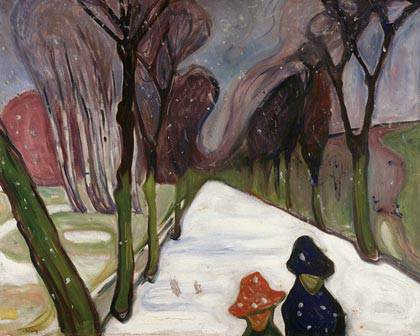
Edvard Munch
New Snow in the Avenue, 1906
© Munch-museet /Munch-Ellingsen-Group / VG Bild-Kunst, Bonn 2012
Edvard Munch. The Modern Eye – Schirn Kuntsthalle The exhibition in the Schirn, which has been prepared together with the Centre Pompidou in Paris, gives the little-researched late work until 1944 special emphasis and proves that Munch was not only an artist of the nineteenth, but also of the twentieth century.
February 9 – May 13, 2012.
]]>
Source: Schirn Kuntsthalle
Besides the approximately sixty paintings and twenty works on paper, two chapters of the presentation are reserved for Munch’s own production as a photographer and filmmaker. Fifty vintage photographs as well as four films will be included in the show. A further dimension of the exhibition highlights how the artist dealt with one and the same motif in drawing, photography, painting, the field of graphic art, and even sculpture and shows that the frequent return to certain motifs constitutes an important key for understanding Munch’s oeuvre.
Repetitions
In copies, revisions, and variations, Munch often returned to certain subjects after years or even decades. Six versions of The Sick Child, seven of Girls on the Bridge, and ten of the Vampire reveal repetition as one of the crucial constant factors in Munch’s work. This reiteration across the whole range of different media available to him not only shows an almost manic obsession with this subject, but also reveals that Munch was the artist of his generation who addressed the issue of the reproducibility of works of art so fundamental in the twentieth century with the greatest acuity.
Self-portraits
Self-portraits run through Edvard Munch’s oeuvre like a thread. From his beginnings to his death, the artist intensely explored his persona in more than seventy paintings and graphic works as well as in over one hundred drawings, watercolors, and sketches and thus left us a visual autobiography, as it were. While he produced only five self-portraits in the course of the nineteenth century, their number increased to more than forty in the years from 1900 to 1944 – not to mention the many drawings, engravings, and photographs.
Photography
Like Pierre Bonnard, Édouard Vuillard, and Alfons Maria Mucha, Munch was one of a generation of artists that took up photography at the turn of the century. In 1902, he bought a small Kodak camera in Berlin and started to take pictures not only of paintings and places associated with certain memories for him, but also increasingly of himself.
Related content
Edvard Munch – The Scream – masterworks of painting
Follow us on:


